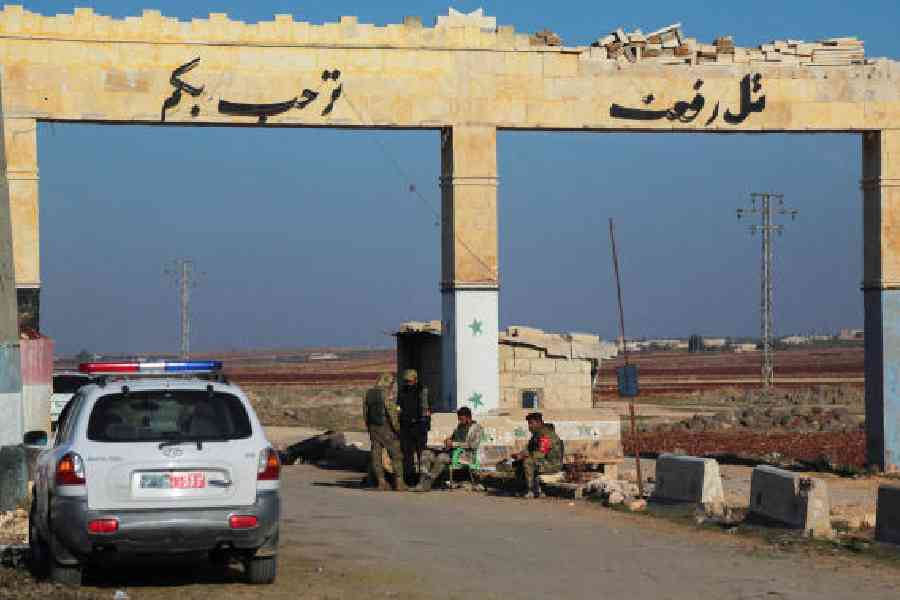The skies were quiet the other night in the northwestern town of Tel Rifaat, Syria, and relief was palpable among fighters and civilians who have lived for years under the constant threat of bombardment.
A man named Ali, 48, guarded the northern entrance to town, sitting in a chair on the road next to a wood stove at an old police post. He gave only his first name for security reasons. But there was no danger of attack, he said, and no bombing.
As night fell in the courtyard of a primary school, Syrian rebel fighters from the town — who helped recapture it from government-allied forces less than two weeks ago — knelt for the evening Muslim prayer. They were still elated by their victory, which ended their own lives of displacement, spent in tents, and those of many families from the town, who were already coming home.
“The people of Tel Rifaat really wanted to return to their town,” said Firas Alito al-Ageid, 40, commander of the rebel unit. “This was the most important thing. They had the desire to return.”
A farming town of some 50,000 people before the civil war that erupted in 2011, Tel Rifaat was first controlled by forces opposed to the government of President Bashar al-Assad, who fled to Russia this month. It was well known as a rebel stronghold — surrounded by many towns loyal to the government — and almost every family contributed fighters to the Opposition.
But in 2016, Tel Rifaat was captured by Syrian Kurdish fighters who backed the Assad regime and who then jointly controlled the town with the government. Most residents fled their homes.
For the past eight years, rebel fighters had been trying to regain territory in this pocket of northwestern Syria, including in Tel Rifaat. Late last month they succeeded.
On Friday, rebel fighters and commanders — part of the Opposition Syrian National Army, an umbrella group backed by Turkey that earlier was known as the Free Syrian Army — tried to explain how their lives, and their struggle against the government of al-Assad, had turned around so suddenly and unexpectedly.
“It was a surprise,” said Muhammad Alito, 33, one of the fighters. “It was impossible. It is from God that we are back in our land.”
Alito’s unit had entered the town at night and fought for just half an hour before victory came and the last fighters holding the city pulled out, he said. He showed a video he took on his cellphone as he and other fighters drove through the town’s dark, empty streets on December 1.
The commander of Alito’s unit, al-Ageid, had another explanation. The rebel offensive was well prepared and benefited from a joint command that coordinated all the various rebel units, making the operation more effective than previous efforts, he said.
And, al-Ageid added, the rebels encountered fewer airstrikes than usual, and there was a new and notable weakness on the side of the Assad government. Its soldiers withdrew from their post in the town before the main fighting started, as they risked being encircled by the rebel advance, he said.
Hezbollah and Iranian militias, which had supported the Syrian government and held frontline positions several miles from Tel Rifaat, had already reduced their presence in recent months.
Kurdish fighters remained in Tel Rifaat to the end but could not hold it, al-Ageid said. The rebels attacked from four directions, leaving an escape route open toward the east, and after three days of fighting, the Kurdish militias retreated.
No planes came to help them, he said.
“There were very few airstrikes,” al-Ageid said. “And when they did bomb, they hit civilian targets. They did not hit the front lines.”
The town is badly damaged from the years of fighting, with houses flattened in places from airstrikes by the government eight years ago when it recaptured Tel Rifaat. But civilian life is returning. Displaced families were clearing rubble and cementing a roof on Friday. Children played in alleyways as fighters embraced friends and relatives on the streets and sat in plastic chairs drinking coffee.
The northern part of the town is especially badly scarred because the Kurdish fighters had dug extensive tunnels under houses, leaving mounds of earth and stone behind. The tunnels provided safe routes to and from the front line.
New York Times News Service











